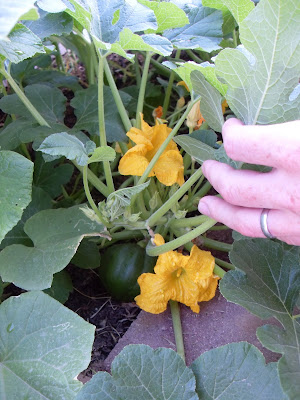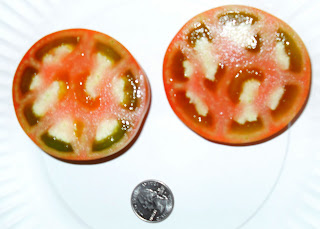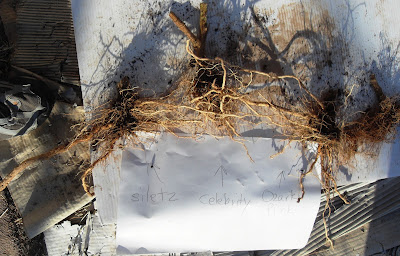Though my Tromboncino butternut squash did well in the Tucson heat, I had seed bugs kill some of the fruit by sucking sap out. This began my search for a squash variety that could outgrow the critters and produce more food per fruit. I settled on the largest Moschata variety I could find, Long of Naples. I procured this fine Italian variety from Baker Creek Heirloom Seeds.
My Long of Naples plants began very vigorously but were very slow to start fruiting and took up to 80 days before having the first female flowers blossom. As with many fruiting plants, if you have a large plant that sets its first fruits, each fruit can grow rapidly – even up to a pound per day. Long of Naples squash averages 25 pounds per fruit. At that point they begin to harden up into a winter (long-term storage) squash. Before that, you can pick the larger fruits when they are between 10-15 pounds as a summer (zucchini type) squash. I gave a 15 pound Long of Naples summer squash to a friend, who took over an hour to just cut the thing up.
Though my Tromboncino butternut squash did well in the Tucson heat, I had seed bugs kill some of the fruit by sucking sap out. This began my search for a squash variety that could outgrow the critters and produce more food per fruit. I settled on the largest Moschata variety I could find, Long of Naples. I procured this fine Italian variety from Baker Creek Heirloom Seeds.
 |
| My daughter with a 25 pound squash |
My Long of Naples plants began very vigorously but were very slow to start fruiting and took up to 80 days before having the first female flowers blossom. As with many fruiting plants, if you have a large plant that sets its first fruits, each fruit can grow rapidly – even up to a pound per day. Long of Naples squash averages 25 pounds per fruit. At that point they begin to harden up into a winter (long-term storage) squash. Before that, you can pick the larger fruits when they are between 10-15 pounds as a summer (zucchini type) squash. I gave a 15 pound Long of Naples summer squash to a friend, who took over an hour to just cut the thing up.
All considered, my two long of Naples Squash plants produced almost 500 pounds last fall – a real feat given the limited space of my garden. For a few days I had almost 400 pounds curing in my house at once. My largest squash was 43 pounds. My wife told me to take it to the county fair. I would have but they do not accept produce entries in the Home Arts division. Too bad.
It is safe to say that Tromboncino can produce way too much food – even for my family of 6 – so I was forced to sell some of my monsters to those who would like a vegetarian feast. So how many ways can you eat squash? Plenty. We've had squash in lasagna as the noodles, in cornbread with a white sauce, in spaghetti, in various casseroles, and in lots and lots of pies. The flesh begins white when young but develops a dark orange flesh as it matures. The flesh is sweet though the texture is not as smooth and buttery as some when fully mature.
 |
| Nearly 400 #s with a pencil for perspective |
All considered, my two long of Naples Squash plants produced almost 500 pounds last fall – a real feat given the limited space of my garden. For a few days I had almost 400 pounds curing in my house at once. My largest squash was 43 pounds. My wife told me to take it to the county fair. I would have but they do not accept produce entries in the Home Arts division. Too bad.
 |
| A delicious summer squash |
It is safe to say that Tromboncino can produce way too much food – even for my family of 6 – so I was forced to sell some of my monsters to those who would like a vegetarian feast. So how many ways can you eat squash? Plenty. We've had squash in lasagna as the noodles, in cornbread with a white sauce, in spaghetti, in various casseroles, and in lots and lots of pies. The flesh begins white when young but develops a dark orange flesh as it matures. The flesh is sweet though the texture is not as smooth and buttery as some when fully mature.
 |
| My waning squash plant soon before the first freeze |







